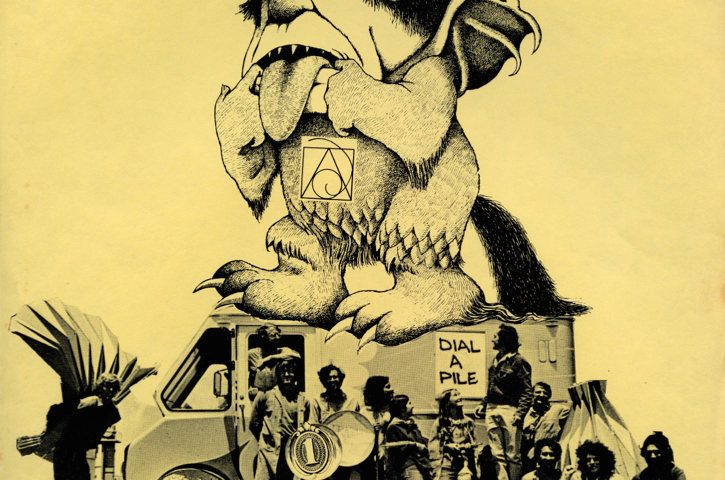The first part of the interview with Greg Castillo looks at the “Design Radicals” exhibit that he cocurated for the University of California, Berkeley. This second part looks at the legacy of these efforts and what they might portend for the future.
Interviewer: I want you to try and put this brief shining moment in a larger context.
Greg Castillo: The “Design Radicals” show is part of a larger research project trying to understand the role of Berkeley as a nexus of countercultural design. Currently, I’m putting together some ideas and writing an article for a catalog for an exhibition that’s being put together by Andrew Blauvelt at the Walker Art Center called “Hippie Modernism: The Struggle for Utopia.”
That show really is the first venture to elevate hippie cultural production as something that we can study as a facet of modernism. My contribution for the catalog is an essay, which I’m calling “Counterculture Terroir: California’s Hippie Enterprise Zone.” My organizing idea for that piece is that Northern California, with Berkeley occupying an important position, was this nation’s (and thus the world’s) preeminent nexus of networked countercultural enterprises. Richard Florida has argued that San Francisco became a premier “creative class” enclave because some key attributes were present—talent, tolerance, and technology. The same Bay Area resources yielded an amazing variety of experiments in counterculture design. Of course, you had San Francisco as a pilgrimage site for hippies from all over the world. And even though things got ugly there after 1967 and the Summer of Love, that very crisis increased Berkeley’s importance as a haven for hippie enterprises.
Interviewer: Berkeley replaces San Francisco as a counterculture center?
Castillo: As an intellectual center and also a very political center of alternative culture, Berkeley became much more important after the Summer of Love. When hippies who were living in the Haight saw what was happening there, many of them got turned off and moved to Telegraph Avenue. They made the street one of the Bay Area focal points of countercultural activity, as we see with the subsequent “guerilla gardening” that created People’s Park.
The university had a special role to play in this. It’s a place that had an enormous amount of brainpower that was also politically galvanized and open to countercultural activities. For example, in Berkeley, a “pharmaceutical dilettante” named Augustus Owsley Stanley III looked up the recipe for LSD in the Chemistry and Chemical Engineering Library, perfected it, and started producing it in a home lab in Orinda. He was the Henry Ford of psychedelics transport, providing the transport mechanism for the Summer of Love. You also have people like Sim Van der Ryn, whose position—with one foot in academia and the other in the counterculture—allowed him to write grants to federal funding agencies and get resources to conduct social research and building experiments. And you had an inexhaustible supply of students—a human resource of very committed people willing to labor for close to nothing on projects they identified with quite passionately.
I’m currently trying to track down web of enterprises that spread out from or crossed paths with Berkeley. I want to map this countercultural network, this hippie regional enterprise zone, that flourished here in the late 1960s and early 1970s.
Interviewer: But don’t you think that there’s a split between the work of this Wurster Hall political poster factory and some of these later enterprises? Because they get co-opted into the mainstream via institutions like the Whole Earth Catalog or Esalen. Even Sim becomes the state architect during Jerry Brown’s first term! They don’t challenge the dominant narrative but end up going mainstream.
Castillo: That’s a narrative I reject. I don’t buy the argument that Stewart Brand’s Whole Earth Catalog was hopelessly compromised by its relationship to American consumer culture or its military connections. Energy-conscious architecture certainly goes mainstream with Sim’s program of energy-efficient state office buildings for Jerry Brown, for example, but that’s far from complicity with the dominant narrative of U.S. energy use. This was a radical intervention into a building type. Some of those experiments worked, some didn’t. To make the argument that they’re co-opted implies that the counterculture can never replicate itself or transform itself: it has to remained locked in a single, historical moment of resistance. But the strategies of resistance have to be able to change. I see resistance in later projects, as well, like in Sim’s book Toilet Papers: Recycling Waste and Conserving Water. It’s very interesting, and has certain parallels with French critical theory. Do you know the book titled History of Shit?
Interviewer: No.
Castillo: That was a book by a French philosopher of the early 1970s, Dominique Laporte: it’s been translated by Rodolphe el-Khoury, who’s now the dean of the University of Miami School of Architecture. Both books explore an area that’s off limits for cultural discourse. In France, it’s approached by a philosophical radical through a very convoluted discourse. It’s a textual performance piece about the relationship of waste management and emergence of modern cities, nation-states, and individual identities. In Toilet Papers, Sim’s basically saying, “You know what? Shit is, shit happens, and our response to it has been, ‘Let’s make it disappear. Let’s make it disappear visually, physically, and especially culturally and mentally.’” Sim is looking for an alternative to the technological absurdity of a complex system that uses water as a resource to flush waste away and then separates the waste back out so that water can be returned to the environment.
In one of Sim’s courses, I think it’s the energy course, we have a paper written by a student which is the autobiography of a turd—the story of a turd emerging into the world, immediately being shunted through a labyrinthine set of conduits, through a building, under streets, to end up in the Bay or a sewage treatment plant. In a way, it’s impossibly vulgar, even now really crazy to think this was an undergraduate research paper, but fundamentally it’s radical for students to be thinking about ecologically vital things that are supposed to be so off limits that we can’t even discuss them.
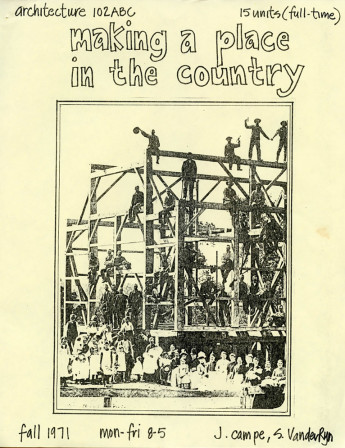
Syllabus
courtesy: Jim Campe
Interviewer: I see a split along Marxist lines between these two activities. That is, I think that the production of graphics to stop the war was more about challenging the sociopolitical/economic dominant culture. But the work of some of these teachers and students here might have been influenced by the radicalism but is not challenging the basic economic order.
Castillo: I would disagree with that. First, I wouldn’t want to mix too much Marxism in it, because I think that these students may have had some ideas about communality that were wonderful, but also quite utopian and abstract. They really weren’t Marxists. And while they were not in it for profit-making, they did sell things at a profit that they poured into other projects. Yet many of these projects involve enormous resistance to the idea of a consumer culture. The recycling of everything, the idea that you would scrounge through trash and take it to children as a resource to teach them things, was an affront, in a way, to what middle-class America would consider good parenting: you don’t bring stuff from the trash to your children to play with or learn from.
There is an argument to be made that their idea of alternative building was quite naïve, the idea that cities are becoming impossible, so let’s move to the countryside, let’s live off the grid. They’re using Buckminster Fuller’s systems idea to understand the world as a totality, as a system in which everything’s plugged into everything else. But there’s a part of them that believes in a place outside of that system; when we move to the countryside and start growing our vegetables and using recycled things, we won’t be a part of the system.
Clearly there’s a logical inconsistency in that. But I would give them a break. One walks away from the city in order to have space to become somebody else. For some of these young people, it meant trying to invent a life that wasn’t confined by the strictures of “When you ‘grow up,’ you’ll have your own family, and you’ll live in your own suburban house.” They wanted to see if there was a place outside of that hand-me-down world.
Interviewer: So do you think there is the link between the antiwar movement and some of the early hippie enterprises? Do you think that the Free Speech Movement and the war resistance are part of that link, allowing everyone to rethink everything, to think, “It’s all up for grabs”?
Castillo: A lot of things are up for grabs at this time. And we can’t deny the role of psychedelics in that. It’s odd now, because we think of them as recreational drugs today. And it’s so hard to imagine a time when somebody would take LSD and experience an entire world, one they had never understood was a construct, suddenly being deconstructed. We all sort of accept that, you know, you’ll take some mind-altering substance and you’ll live a different reality for a little while. But at that point, mood- and mind-altering technologies were new and crude, and made the airtight totality of a world collapse for people.
In looking back at the counterculture era, you can see drug use as utterly self-indulgent, just like you can create a narrative about antiwar resistance that makes it utterly self-serving. Campus antiwar resistance happened after Nixon installed a selective service system that worked by lottery, which essentially overrode all student deferments. So for the first time, students whose social privilege included being in college confronted the notion that next year they might find themselves in a jungle shooting it out with guerilla fighters. It’s not surprising that campuses didn’t blow up before that. It was the coming of the lottery system that generated the anguish and anger that’s expressed in the poster-making project.
Interviewer: Because now privileged, middle-class white boys are going to war.
Castillo: Of course American college students at that time tended not to be disadvantaged minorities. Even blue-collar working-class people were relatively underrepresented. It was really the privileged middle-class white men who suddenly realized that they weren’t immune to the risk of dying in a jungle.
Interviewer: Do you see a link to what’s happening now, this movement of architecture and social activism in organizations like Public Architecture, Mass Design, and even the Autodesk Foundation?
Castillo: I hope that, in looking at this particular historical moment, students in architecture school would read it as a potentially usable past and recognize that it isn’t a moment of hippie nonsense but an extremely productive, challenging, and interesting if frenetic activity. There are connections to our state of perpetual warfare and social inequity. I think that’s what gives this particular historical legacy its bite today.
Of course, just as there should be questions about architecture students going “back to the land” to build communes, there are enormous problems today with the model of architectural students going into Haiti for a one-time intervention. These problems exist on many levels, on cultural levels, on the fetishistic notion of professional expertise. I find it especially disturbing when these paradigms of help for the global south get fed back into glossy journals as an exciting new exploration area for modes of architecture which look pretty damn cool, which some of them do, while purporting to address these problems. But these tensions are normal and have to be acknowledged. You could not have students from the United States go to Latin America or to Africa, or even rural Mississippi, and make those kinds of interventions and not ask questions about it. I think that’s a good thing. But it does have at least as many tensions embedded in it as any of the student work of the counterculture era does.
Interviewer: In an earlier document, you wrote about the Aspen Design Conference and the French critics challenging these activists from Cal.
Castillo: That’s not part of this show. But it’s very much a part of the larger project.
Interviewer: Could you expand on that?
Castillo: It’s another one of Sim Van Der Ryn’s creative uses of grant money. Some of his research funds end up being used to rent a bus to transport ecological activists—self described “eco-freaks”—to the Aspen Design Conference. It’s like Ken Kesey and his Merry Pranksters descending on the Aspen, a conference attended by designers who are empowered, entitled, and often part of the extremely provincial New York design world. They are flying to Aspen to talk about their glossy ideas, and suddenly there are people playing drums and doing ritualistic dances and psychodramas about environmental warfare in front of them. It was an intervention that was intended as a disruption, and it did cause people to wonder if the Aspen Design Conference had a future, whether it was time to disband it or not; whether it had lived out its purpose.
Sim also funded travel for group of French philosophes to the same Aspen conference. And they had no time for the hippies, because their view of activism was largely Marxist. When Jean Baudrillard and Jean Aubert saw these eco-activists acting out as shamans, they feel it is utter nonsense. In a statement titled “The Environmental Witch-Hunt,” the so-called French Group attacked the idea of ecology that these hippies stood for, saying the whole idea of an ecological crisis is a lie, a form of “boy scout idealism” that creates a false sense of social interdependence between class antagonists. To the philosophes, the idea that the environment is at risk of collapse was a hoax intended to perpetuate the collusion of workers with the owners of the means of production. Any idea that ecology would be an issue worthy of being addressed was, for Baudrillard and Auber, a feel-good fantasy that would unite class elements that would otherwise be locked in mortal combat, making the eco-freaks who were “shouting apocalypse” nothing more than quislings dressed as medicine men.
Interviewer: Do you think the philosophes were right?
Castillo: I think theirs was the last gasp of a totalizing ideology that could exist as such in its own airtight world. A world on the verge of catastrophic climate change couldn’t register as a problem to the philosophes because it didn’t conform to the Marxist rule book of historical transformation through class struggle. It is an interesting moment that highlights the weaknesses of both camps because, if you see the film that was made of the eco-freaks at Aspen, the counterculture camp seems fixated on disruption rather than dialogue. Their intervention was a psychedelic variety of narcissistic psychodrama.
Interviewer: But who controls the corporations that have brought us to this moment of collapse?
Castillo: You mean because the oil companies’ profit model is predicated on the demolition of the planet?
Interviewer: Right. And they are able to keep electing politicians that support them. So is there some part of the Marxist argument that still holds up?
Castillo: But the part of it that is problematic, unless you’re going to buy into the notion of false consciousness, is the fact that it is working-class people, people who buy at Walmart to get it for cheap and get the next one even cheaper when it breaks, who are pouring in the money that bankrolls the destruction of the planet. In other words, when we offshore production to China, we are ensuring that we will buy products that have generated the maximum amount of pollutants into the air, that we all breathe. Production is offshored because a part of the savings in production cost comes from not having to account for how much air, land, and water gets polluted. That we like to buy cheap stuff and throw it away makes us accomplices to the ecological demolition derby, whether our collar is blue or white.
Interviewer: So you’re saying in a way that these design radicals were onto something key because they were posing a criticism of consumer culture, which has both the working and middle classes involved because they’re consuming?
Castillo: Absolutely.
Interviewer: So the standard Marxist argument falls apart because the middle and lower classes are complicit in consumerism.
Castillo: Ecological activists and radical recyclers, who were at the heart of the Bay Area design radicals of the late 1960s and early 1970s, posed the idea that a new evolution in consciousness would be one in which you understood the world as a closed system, that essentially any pollutants that you created, either in manufacturing something or with your body, would need to be accounted for, and you should take responsibility for it. That was the idea that percolated through architectural coursework and experiments by Sim Van der Ryn and Jim Campe. It started with their reuse of castoff materials to create new learning environments at Berkeley elementary schools, using a retooled mail van as a mobile lab with the motto “trash can do it.” It continues with the Outlaw Builders Studio, with its commitment to building a new community in both the social and physical senses through collective foraging and reuse of found materials. Scavenging as an art form was a regional specialty, by the way; it goes back to the Beat culture of the 1950s and the emergence of Bay Area assemblage as an art movement. Sim’s architectural contribution includes the Energy Pavilion, which was the initial step toward the later Integral Urban House experiment, where many of his ecological ideas came together.
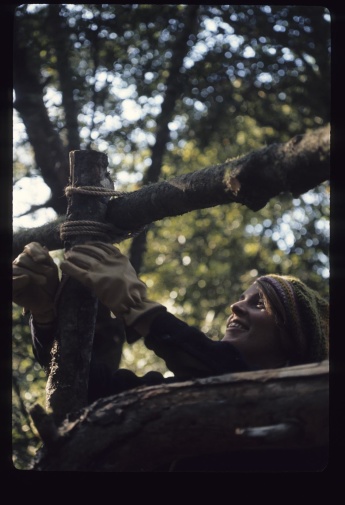
Outlaw Builder
courtesy: Jim Campe
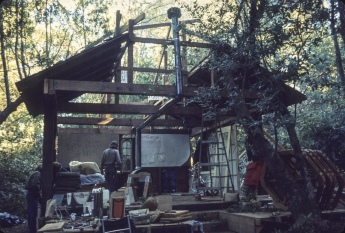
Outlaw Builders Communal Studio Building
courtesy: Jim Campe
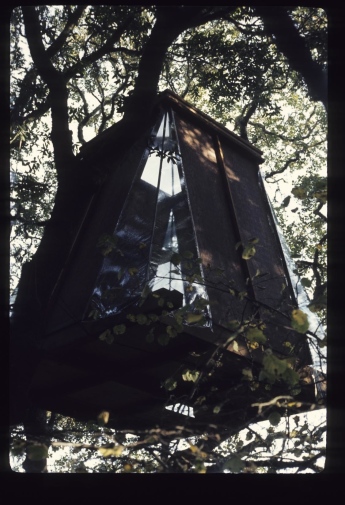
OutlawBldrs hanging sleeploft
courtesy: Jim Campe
Sim and organic gardeners Bill and Helga Olkowski and the crew at the Farallones Institute found a turn-of-the-century worker’s cottage for sale in West Berkeley in the mid-1970s. At the time, this was a pretty undesirable neighborhood, and houses were cheap—this was a sort of “trash can do it” approach to urban homesteading. And while the house was cheap, they were also looking at it from a different perspective. This part of Berkeley, along the waterfront freeway, has the town’s richest soil, because it’s where the alluvial wash flowed down from the hillsides.
They rehabbed this cottage to create a self-reliant life support system—the Integral Urban House. Philosophically, it’s related to the counterculture’s romance with holism and systems design, a topic that Simon Sadler at Irvine has written about. The result was a demonstration house, staffed by volunteers and open to the public, where you could find out how to apply environmentalist principles to your own life. It was an educational tool designed for mass ecological transformation. They raised varieties of local freshwater fish in an experimental aquaculture pond in the front yard. The small backyard had fruit trees, chicken coops, rabbit hutches, beehives, and raised vegetable beds; they were fertilized with compost made from chicken manure, rabbit droppings, plant clippings, and kitchen waste. Greywater from sinks and drains went to water plants. The house also had a composting toilet from Sweden that wasn’t code-legal in the United States, so its wastes couldn’t be used in the garden. A solar heating panel supplied hot water. South-facing windows dropped sunlight on an indoor wall of water bottles as a heat sink. On sunny days, they used a solar oven to bake bread.
Sim and the Farallones Institute got another popular book out of this project. The Integral Urban House: Self Reliant Living in the City, published by the Sierra Club, became a sort of bible for urban homesteaders. Of course, there are many tensions in the idea of an autonomous house. The claim was that even an apartment dweller could switch to self-reliant homemaking and participate in an ecological revolution while keeping their urban lifestyle intact. But how many people want to come home from work, change, and then go out to slaughter and gut a rabbit? The Integral Urban House worked as an ecological display until the early 1980s, at which time the neighborhood begins to gentrify. And lo and behold, the new neighbors did not appreciate the smells coming out of composting toilets and rabbit hutches next door. What really ended up killing this autonomous house experiment was the fact that it wasn’t really autonomous, that flies and smells leave your yard and go next door where somebody has just mortgaged themselves to the hilt to buy a fixer-upper in the next good neighborhood.
Interviewer: You’re part of a larger ecosystem wherever you are. So what’s next in terms of your research?
Castillo: The next step is a “Design Radicals” anthology that will assemble stories of many of these experiments to paint a broader portrait of the Bay Area as a hub of counterculture innovation. The scale and number of activities going on here exceeded those that could be found anywhere else in the world. When you start looking at some of the institutions that are hallmarks of the counterculture, for example, underground presses, the number was enormous in the Bay Area compared to New York. From the beginning of the poster renaissance of the 1960s through the present, the Bay Area has produced more independent political posters than anywhere else on earth, as Lincoln Cushing has pointed out. And our local counterculture legacy is attracting international research interest.
For the Design Radicals anthology, a distinguished architectural historian from Paris, Caroline Maniaque-Benton, is looking at the way French visitors saw and reinterpreted Bay Area experiments. Lionel Devlieger, one of the co-curators of last year’s Oslo Architecture Triennale exploring the desire for sustainability, which included a number of Sim’s projects, will be writing about the Outlaw Building Studio for the anthology. From the University of Sydney, Lee Stickells will be putting the Integral Urban House experiment into its international context. This wasn’t cultural imperialism, where things are being sent out and transplanted exactly as they are in the United States. Very different versions of alternative culture were built based on local interests and conditions in different places.
There are other forms of hippie globalization that the anthology will address. For example there is a piece by Padma Maitland, a South Asia Studies scholar at UC Berkeley, on the mandala as an icon of Bay Area graphic arts counterculture. Pat Morton from UC Riverside will be writing on J.B. Jackson’s impact on the architectural thought and practice of a number of alternative design talents. Marta Gutman from CCNY, who’s one of the foremost scholars of the childhood design environments, will be contributing a piece on Jim Campe and the Odyssey elementary school experiments and countercultural educational reform. And Anthony Raynsford, who’s giving a talk in the Design Radicals lecture series in November, is working up a chapter on Wurster Hall’s relationship to the making of People’s Park, an early and important example of guerilla gardening and the grassroots creation of public urban space. The Bay Area’s counterculture design legacy is a rich, rich topic, and we’ve only begun to scratch the surface.
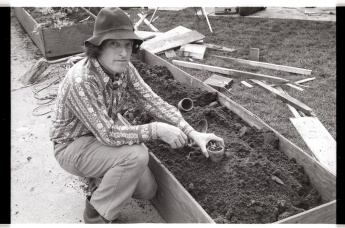
Sim Van der Ryn
courtesy: Jim Campe
